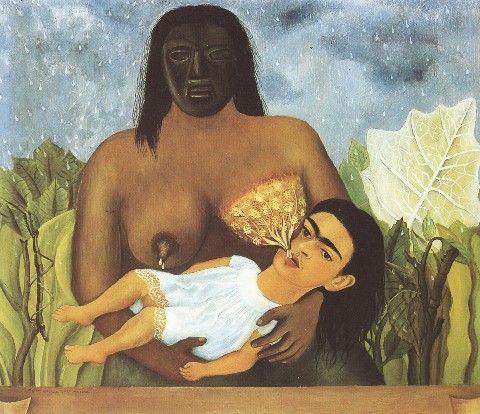My Nurse and I
1937
Frida's mother was unable to breastfeed her because her sister Cristina was born just eleven months after her. She had to be fed by a native Indian wet-nurse whom the family hired for that sole purpose but was later fired for drinking on the job. The relationship between them appears distant and cold, reduced to the practical process of feeding. Because it was the adult Frida who had the memory, the baby has an adult head, and because she could not remember her wet nurse's facial features, she covered her face with a pre-Columbian funerary mask. Frida wrote about this painting saying: "I am in my nurse's arms, with the face of a grownup woman and the body of a little girl, while milk falls from her nipples as if from the heavens."
The wet nurse does not embrace nor cuddle Frida... she displays her like a sacrificial offering. The unfurled blank scroll along the lower edge of the painting suggests that Frida thought of it as an "ex-voto" but never inscribed the scroll. In this painting, Frida transformed the "Madonna and Child" mothering image into an expression of loss and separation from her own mother with whom she never really bonded.
Frida considered this to be one of her most powerful works and is another painting in her series to document major events in her life. A pre-Columbian idol from Diego's personal collection may have been the model for this painting.
In the original version of this painting, Kahlo had short hair. She later lengthened it.

(Click Here to View Larger Image)
(Pinche aquí para ver la imagen aumentada)
Oil
on metal
12" x 14 ½"
Dolores Olmedo Patiño Museum
Mexico City, Mexico
Óóleo sobre metal
30,5 x 37 cm.
Museo Dolores Olmedo Patiño
Ciudad de México, México

Mi nana y yo
1937
La madre de Frida fue incapaz de amamantarla porque su hermana Cristina nació justo once meses después de ella. Ella tuvo que ser amamantada por una nodriza, una india, a la cual la familia contrató para esta función solamente, aunque más tarde fue despedida por beber en horas de trabajo. La relación entre ellas parece distante y fría, reducida al proceso práctico de alimentación. Debido a que el recuerdo pertenece a la adulta Frida, el bebé tiene una cabeza de adulto, y porque Frida no podía recordar las facciones de la nodriza, la pintó con la cara cubierta con una máscara funeraria precolombina. Frida escribió acerca de este cuadro diciendo: "Estoy en brazos de mi nodriza, con la cara de una mujer adulta y el cuerpo de una niñita, mientras leche cae de sus pezones como si fuera de los cielos"
La nodriza no abraza o acuna a Frida... la muestra como una ofrenda para el sacrificio. El espacio para un texto en la parte de abajo del cuadro sugiere que Frida pretendía pintar un"ex-voto" pero nunca llego a escribir el texto. En esta pintura, Frida transformó la expresión maternal de la “Madonna y niño” en un reflejo de perdida y separación de su propia madre, con la cual nunca estuvo muy unida.
Frida consideraba ésta una de sus obras más poderosas y es otra pintura en su serie que documenta los eventos más importantes de su vida. Un ídolo pre-Columbino podría haber servido de modelo para esta pintura.
En la versión original de esta pintura Frida tenía el pelo corto. Más tarde lo alargó.